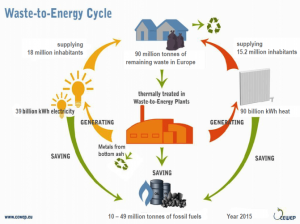Waste-to-energy in Europe
SYMBIOSIS project promotes re-manufacturing, reuse and recycle, and transforms one industry’s waste to another’s raw material and/or fuel, to pave the way for a more circular economy for the regions, where waste is eliminated and resources are used in an efficient and sustainable way.
However, today’s linear economic model (take-make-waste) generates mountains of waste. It involves the extraction and processing of virgin raw materials, while products and packaging are used and then thrown away. In a shift away from a linear economic model, the European Union adopted the Circular Economy Package in 2018. The package introduces new waste management targets. For municipal (household) waste, it sets a 10% cap for landfilling and a recycling target of 65% by 2035.
The circular economy is an economy in which waste of a process of production and consumption are circulating as a new entry in the same or different process. To successfully close the loop, we must focus on quality as well as quantity. Working for a circular economy means focusing on products of longer duration, developed for the upgrade, aging and repair, considering strategies such as sustainable design.
The circular is also a form of economy that is more collaborative, which focuses on the property and not so much the product as such, but its function and its use. The circular economy is an economy in which waste of a process of production and consumption are circulating as a new entry in the same or a different process. All this inevitably leads to greater collaboration between companies, but also between the public administration, research and companies themselves to find new operational solutions.
As Europe seeks to address its waste challenges, waste-to-energy will continue to provide essential waste treatment where recycling is not appropriate and to offer a source of secondary raw materials and energy for the circular economy. Waste-to-energy also contributes to the EU’s 2030 targets for greenhouse gas emissions reduction and for renewable energy adopted in 2018.
In this direction, there is the important effort of Confederation of European Waste-to-Energy Plants (CEWEP) an umbrella association of the operators of Waste-to-Energy plants, representing about 400 plants from 23 countries. They make up more than 80% of the Waste-to-Energy capacity in Europe, ensuring high environmental standards, achieving low emissions and maintaining state of the art energy production from remaining waste that cannot be recycled in a sustainable way. Their vision is for a well-functioning circular economy in 2035 where quality recycling is steadily increasing and landfilling is limited to a minimum, an integrated waste management system with Waste-to-Energy as a cornerstone of the circular economy.
CEWEP’s technology and processes will become increasingly resource-efficient. Clean minerals and metals will be recycled from bottom ash. Carbon dioxide (CO2) from the flue gas is captured and used where appropriate and sustainable. Our industry continues to pursue best practices, to implement best available techniques (BAT) and develop innovative technologies to improve efficiency and reduce emissions. The Waste-to-Energy sector also is committed to engaging with neighbouring communities to help reduce their dependence on fossil fuels.
In the picture below is demonstrating the Waste-to-Energy cycle from CEWEP as it was described above.

For more info about CEWEP click here
Disclaimer
The views expressed in this publication do not necessarily reflect the views of the European Union, the participating countries and the Managing Authority.




